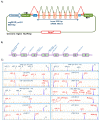RAD51D Aberrant Splicing in Breast Cancer: Identification of Splicing Regulatory Elements and Minigene-Based Evaluation of 53 DNA Variants
- PMID: 34200360
- PMCID: PMC8201001
- DOI: 10.3390/cancers13112845
RAD51D Aberrant Splicing in Breast Cancer: Identification of Splicing Regulatory Elements and Minigene-Based Evaluation of 53 DNA Variants
Abstract
RAD51D loss-of-function variants increase lifetime risk of breast and ovarian cancer. Splicing disruption is a frequent pathogenic mechanism associated with variants in susceptibility genes. Herein, we have assessed the splicing and clinical impact of splice-site and exonic splicing enhancer (ESE) variants identified through the study of ~113,000 women of the BRIDGES cohort. A RAD51D minigene with exons 2-9 was constructed in splicing vector pSAD. Eleven BRIDGES splice-site variants (selected by MaxEntScan) were introduced into the minigene by site-directed mutagenesis and tested in MCF-7 cells. The 11 variants disrupted splicing, collectively generating 25 different aberrant transcripts. All variants but one produced negligible levels (<3.4%) of the full-length (FL) transcript. In addition, ESE elements of the alternative exon 3 were mapped by testing four overlapping exonic microdeletions (≥30-bp), revealing an ESE-rich interval (c.202_235del) with critical sequences for exon 3 recognition that might have been affected by germline variants. Next, 26 BRIDGES variants and 16 artificial exon 3 single-nucleotide substitutions were also assayed. Thirty variants impaired splicing with variable amounts (0-65.1%) of the FL transcript, although only c.202G>A demonstrated a complete aberrant splicing pattern without the FL transcript. On the other hand, c.214T>C increased efficiency of exon 3 recognition, so only the FL transcript was detected (100%). In conclusion, 41 RAD51D spliceogenic variants (28 of which were from the BRIDGES cohort) were identified by minigene assays. We show that minigene-based mapping of ESEs is a powerful approach for identifying ESE hotspots and ESE-disrupting variants. Finally, we have classified nine variants as likely pathogenic according to ACMG/AMP-based guidelines, highlighting the complex relationship between splicing alterations and variant interpretation.
Keywords: ESE; ESS; RAD51D; VUS; aberrant splicing; breast cancer; clinical interpretation; minigene; ovarian cancer; susceptibility genes.
Conflict of interest statement
The authors declare no conflict of interest.
Figures


Similar articles
-
Splicing predictions, minigene analyses, and ACMG-AMP clinical classification of 42 germline PALB2 splice-site variants.J Pathol. 2022 Mar;256(3):321-334. doi: 10.1002/path.5839. Epub 2021 Dec 28. J Pathol. 2022. PMID: 34846068 Free PMC article.
-
Mis-splicing in breast cancer: identification of pathogenic BRCA2 variants by systematic minigene assays.J Pathol. 2019 Aug;248(4):409-420. doi: 10.1002/path.5268. Epub 2019 Apr 23. J Pathol. 2019. PMID: 30883759
-
Functional classification of DNA variants by hybrid minigenes: Identification of 30 spliceogenic variants of BRCA2 exons 17 and 18.PLoS Genet. 2017 Mar 24;13(3):e1006691. doi: 10.1371/journal.pgen.1006691. eCollection 2017 Mar. PLoS Genet. 2017. PMID: 28339459 Free PMC article.
-
Comprehensive splicing analysis of the alternatively spliced CHEK2 exons 8 and 10 reveals three enhancer/silencer-rich regions and 38 spliceogenic variants.J Pathol. 2024 Apr;262(4):395-409. doi: 10.1002/path.6243. Epub 2024 Feb 9. J Pathol. 2024. PMID: 38332730
-
Regulation of alternative RNA splicing by exon definition and exon sequences in viral and mammalian gene expression.J Biomed Sci. 2004 May-Jun;11(3):278-94. doi: 10.1007/BF02254432. J Biomed Sci. 2004. PMID: 15067211 Free PMC article. Review.
Cited by
-
Splicing Dysregulation of Non-Canonical GC-5' Splice Sites of Breast Cancer Susceptibility Genes ATM and PALB2.Cancers (Basel). 2024 Oct 22;16(21):3562. doi: 10.3390/cancers16213562. Cancers (Basel). 2024. PMID: 39518003 Free PMC article.
-
Minigene-based splicing analysis and ACMG/AMP-based tentative classification of 56 ATM variants.J Pathol. 2022 Sep;258(1):83-101. doi: 10.1002/path.5979. Epub 2022 Jul 15. J Pathol. 2022. PMID: 35716007 Free PMC article.
-
Finding significance: New perspectives in variant classification of the RAD51 regulators, BRCA2 and beyond.DNA Repair (Amst). 2023 Oct;130:103563. doi: 10.1016/j.dnarep.2023.103563. Epub 2023 Aug 19. DNA Repair (Amst). 2023. PMID: 37651978 Free PMC article. Review.
-
Splicing predictions, minigene analyses, and ACMG-AMP clinical classification of 42 germline PALB2 splice-site variants.J Pathol. 2022 Mar;256(3):321-334. doi: 10.1002/path.5839. Epub 2021 Dec 28. J Pathol. 2022. PMID: 34846068 Free PMC article.
-
Preliminary evaluation of ShallowHRD performance compared to HRDetect in familial breast cancer tumors.Sci Rep. 2025 Aug 11;15(1):29442. doi: 10.1038/s41598-025-14122-9. Sci Rep. 2025. PMID: 40790321 Free PMC article.

